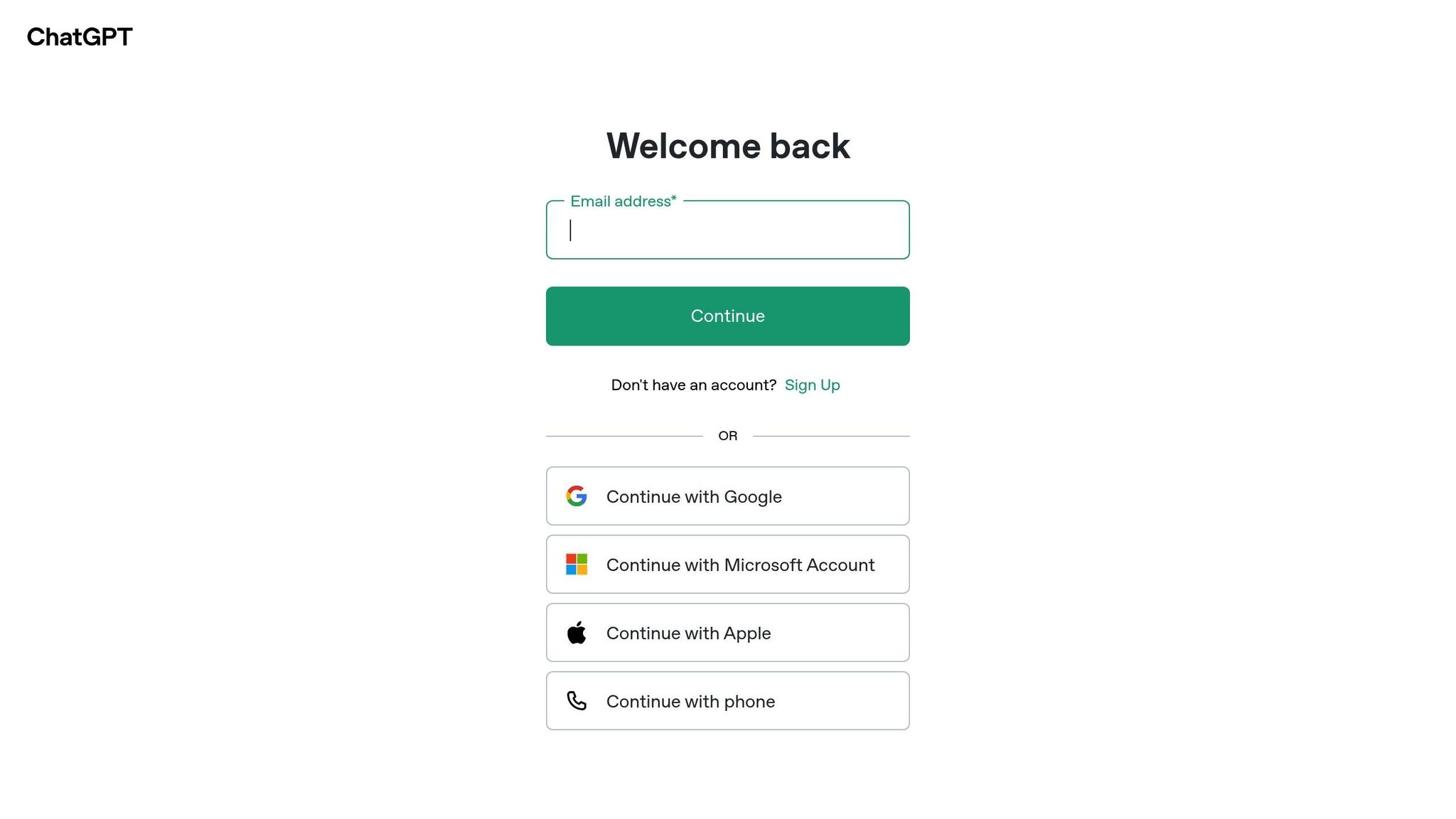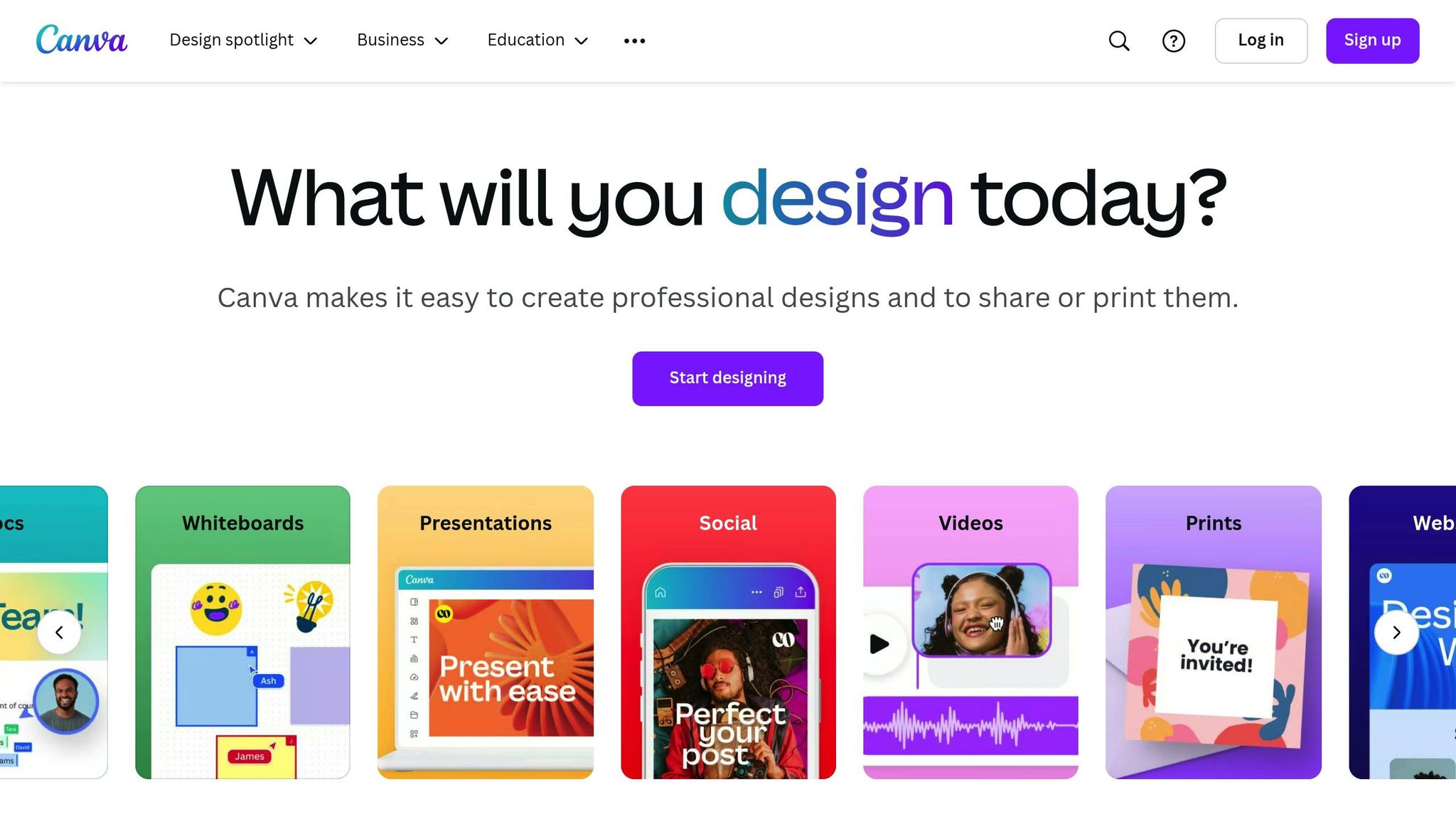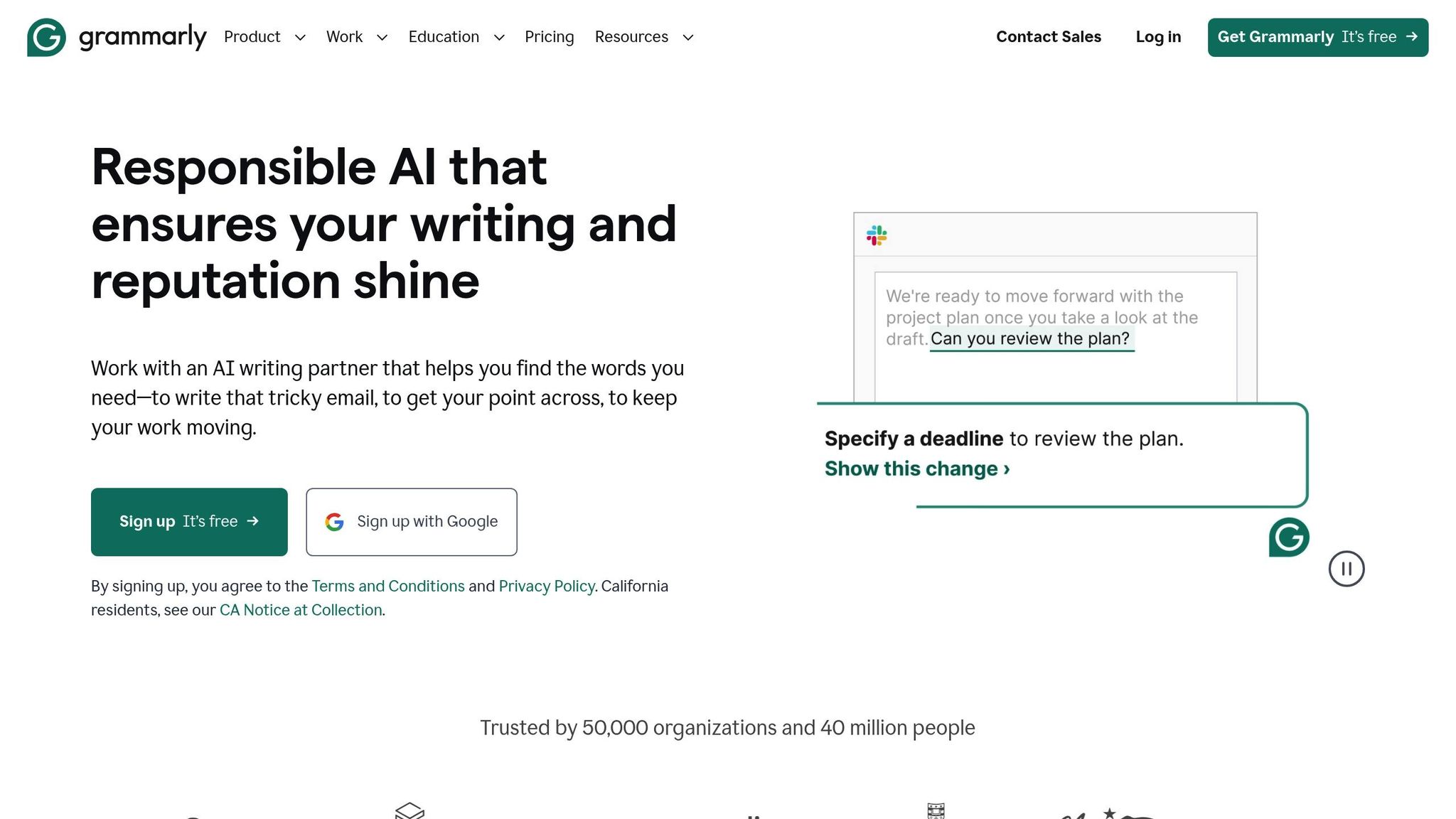AI tools can be both free and paid. Free versions often provide basic features with limitations, while paid plans unlock advanced capabilities. Here's a quick summary:
- Free Tools: Ideal for personal use or testing, but often limited by usage caps, fewer features, and slower performance.
- Paid Plans: Offer better reliability, advanced features (e.g., unlimited GPT-4 access with ChatGPT Plus for $20/month), and priority support.
- Pricing Models:
- Free with Limits: Basic usage (e.g., Grammarly free for grammar checks).
- Subscription-Based: Monthly fees for full access (e.g., Canva Pro at $15/month).
- Pay-as-you-go: Payment based on usage (e.g., ElevenLabs credits).
Quick Comparison Table
| Tool | Free Plan Highlights | Paid Plan Benefits | Cost |
|---|---|---|---|
| ChatGPT | GPT-3.5, 15–16 prompts every 3 hours | Unlimited GPT-4, faster responses | $20/month |
| Grammarly | Basic grammar checks | Advanced writing suggestions | $30/month |
| Canva | Limited templates, 5GB storage | 130M assets, 1TB storage | $15/month |
| ElevenLabs | 10 minutes of text-to-speech generation | More credits, advanced voices | Pay-per-use |
Free tools are great for casual use, but if you need advanced features or higher limits, paid plans are worth considering. Start with free versions to test what fits your needs.
Top 3 Free AI Tools for Beginners
Free AI Tools Overview
Free AI tools come with a variety of features and restrictions. Most operate under a freemium model, offering basic functionality at no cost while encouraging users to upgrade for more advanced capabilities.
Types of Free AI Tools
AI tools across different categories often provide free versions. Here's an overview:
| Category | Popular Free Tools | Key Free Features | Notable Limitations |
|---|---|---|---|
| Chatbots | ChatGPT, Claude | Basic conversations, GPT-3.5 access | 15–16 prompts every 3 hours |
| Writing | Grammarly, Wordtune | Basic grammar checks, simple rephrasing | Limited writing styles |
| Design | Canva AI, Midjourney | Basic templates, limited generations | Watermarked exports |
| Productivity | Asana, ClickUp | Task management, 100MB storage | 10-user limit |
Specialized tools also offer free options. For example, ElevenLabs provides 10 minutes of free text-to-speech generation, while Runway offers 125 credits for video editing without charge.
"AI isn't about creating a troop of robotic salespeople who rely solely on AI to do their jobs. It's about equipping your team with superpowers to close deals faster, understand customers better, and respond quicker." – Collin Stewart, CEO of Predictable Revenue
How Free Tiers Work
Free tiers usually follow specific models that define their benefits and restrictions:
- Token-Based Systems: Tools like Bolt.new allow users to access 100,000 free daily tokens before requiring a $18/month Pro Plan.
- Time-Limited Access: Synthesia offers 36 minutes of free video generation annually, with premium features available in its $29/month plan.
- Feature-Gated Access: Murf provides access to over 120 voices and basic audio sharing in its free plan, but reserves commercial rights and advanced features for its $29/month Creator Plan.
These models are designed to provide basic functionality while highlighting the advantages of paid plans. For instance, Grammarly’s free version focuses on basic grammar corrections, while advanced suggestions are locked behind a $30/month premium subscription. This balance ensures that free tiers remain useful while encouraging upgrades.
Free vs. Paid Features
Understanding the differences between free and paid plans can help you decide which features align with your needs. Below, we break down key features for ChatGPT, Canva, and Grammarly across their respective tiers.
ChatGPT Features Comparison

The free version of ChatGPT provides essential chat functions, while the Plus plan offers expanded capabilities:
| Feature Category | ChatGPT Free | ChatGPT Plus |
|---|---|---|
| AI Model Access | Limited GPT-4; defaults to GPT-3.5 during high demand | Unlimited GPT-4 access |
| Response Speed | Standard | Faster, with priority access |
| Data Analysis | Basic text analysis | Advanced analysis with OneDrive and Google Drive integration |
| Image Capabilities | Basic image analysis | DALL-E 3 image generation |
| File Handling | Limited uploads | Higher upload limits |
"Enhanced data analysis in ChatGPT Plus versus the Free version is a great example of how users on the paid, premium tier get cutting-edge features. On the whole, most folks relying on ChatGPT casually should be fine with the no-cost plan, but power users like researchers, content creators or writers may want to spring for the premium version." - Imad Khan, Senior Reporter, CNET
Canva AI Features Comparison

Canva, with over 130 million active users, offers distinct capabilities in its free and Pro plans:
| Feature | Free Plan | Pro Plan |
|---|---|---|
| Templates | 2+ million | 4.5+ million |
| Stock Assets | 3+ million items | 130+ million items |
| Cloud Storage | 5GB | 1TB |
| Magic Write | 50 total uses | 500 uses monthly |
| Dream Lab | 20 uses monthly | 500 uses monthly |
| Brand Kits | 1 kit | 1,000 kits |
Interestingly, 67% of Canva users choose subscription plans. Additionally, educational institutions and nonprofits can access premium features for free through special programs.
Grammarly Features Comparison

Grammarly's free and premium plans cater to different levels of writing assistance:
| Category | Free Version | Premium Version |
|---|---|---|
| Grammar Check | Basic corrections | Detailed, advanced reviews |
| Writing Style | Limited suggestions | Comprehensive style recommendations |
| Tone Detection | Basic | Advanced, with adjustment options |
| Plagiarism Check | Not available | Full scanning capabilities |
| AI Suggestions | Basic recommendations | Enhanced writing suggestions |
| Integration | Limited platforms | Full cross-platform support |
The premium plan goes beyond fixing grammar mistakes, offering tools to refine clarity, tone, and overall writing quality for more polished communication.
sbb-itb-212c9ea
Limits of Free AI Tools
Privacy Concerns
Using free AI tools often comes with a privacy cost. Information entered into these tools is generally not well-protected, comparable to sharing it publicly online.
| Privacy Aspect | Free AI Tools | Paid AI Services |
|---|---|---|
| Data Collection | Extensive collection for ads and improvements | Limited data collection with user controls |
| Data Rights | Providers hold broad usage rights | Users retain more ownership of their data |
| Security Features | Basic encryption and protection | Advanced encryption, GDPR/HIPAA compliance |
| Support Level | Limited or automated support | Dedicated, accountable support |
"When you enter information into a free AI tool, chances are that information is no more protected than if you posted it on a public website or handed it out to passersby on the street."
- UW–Madison Information Technology
These privacy risks are further complicated by the strict limitations these tools impose.
Usage Limitations
Free AI tools often come with restrictions that can hinder productivity and scalability. Common limitations include:
- API Rate Limits: For example, OpenAI's free tier allows roughly 3,000 tokens per minute.
- Processing Caps: Many tools limit outputs to around 10,000 AI-generated words per month.
- Feature Access: Advanced features are typically locked behind paywalls.
- Output Quality: Results may be simplified or truncated to conserve resources.
A 2024 KPMG survey found that while interest in AI tools remains high, about 63% of users are concerned about privacy and cybersecurity risks when using these services.
Beyond these operational limits, free tools often lack critical features that could enhance their usefulness.
Missing Features
Free AI tools frequently omit important capabilities, which can reduce their overall effectiveness. For instance, GitHub Copilot's free version has been shown to produce code with potential security vulnerabilities in about 40% of cases.
Some key missing features include:
- IP Protection: Free versions rarely offer indemnity against intellectual property claims, leaving users exposed [12].
- Quality Assurance: Accuracy checks are often minimal or nonexistent.
- Customization: Limited ability to fine-tune outputs or adjust parameters.
- Integration: Basic or no connectivity with other tools and platforms.
"The model's predictions can be entirely correct within the scope of its data... [if] these systems rely solely on accurate but incomplete data, they risk reinforcing biases and ignoring critical human factors, resulting in unfair or ineffective decisions … AI accuracy is not necessarily the truth!"
- Tshilidzi Marwala, Rector of the United Nations University and Under-Secretary-General of the United Nations
A study by Nudge Security revealed that 67% of users attempt to bypass restrictions in AI tools, showing how these limitations can frustrate users and impact their workflows. Understanding these drawbacks is essential before relying on a free AI service.
Choosing Between Free and Paid Tools
Key Decision Points
Organizations using paid AI tools have reported measurable gains: a 6.2% rise in sales, a 7% improvement in customer satisfaction, and a 7.2% drop in marketing expenses.
Your decision should hinge on how much you use the tool and whether you need advanced features. If your usage exceeds basic limits, paid plans might be the better choice:
- Usage Volume: If you're a heavy user sending more than 15 GPT-4 messages every three hours, ChatGPT Plus ($20/month) could be a cost-effective option. For lighter users, free versions may suffice.
- Feature Requirements: Paid plans often include advanced tools tailored for professional needs. For example, LA/VIE media buying group saw a 247% revenue boost using Akkio's paid predictive models. Free versions are generally better suited for personal projects or learning.
Price vs. Value Analysis
Once you've assessed your usage and feature needs, compare the cost of the tool with the benefits it offers:
| Use Case | Monthly Cost | Benefits |
|---|---|---|
| Individual Creator | $20-$49 | Saves time, improves output quality |
| Small Business | $49-$135 | Boosts productivity, enhances customer satisfaction |
| Enterprise | $400,000+ | Scalable solutions, enhanced security, custom features |
"Don't just look at the price tag. Consider the value the app brings in terms of time saved and financial goals achieved." – Robert Brown, Financial Tech Guru
Interestingly, only 53% of enterprise AI projects successfully move from testing to full implementation.
Feature Comparison Table
Here’s a quick breakdown of the differences between free and paid options:
| Feature | Free Version | Basic Paid | Premium Paid |
|---|---|---|---|
| Model Access | GPT-3.5 | GPT-4 | GPT-4 Turbo |
| Response Speed | Standard | Priority | Highest Priority |
| Security | Basic | Enhanced | Enterprise-grade |
| Support | Community | 24/7 Live | |
| Cost Range | $0 | $20-$50/month | $100+/month |
"Always read the fine print. Your financial data is valuable, and you need to know who has access to it and how it's protected." – Emily White, Cybersecurity Whiz
This framework helps clarify when to stick with free tools or invest in paid plans, depending on your specific needs.
Getting the Most from Free Tools
Free Tier Best Practices
Google Cloud's free AI APIs come with generous monthly allowances, making them a great starting point. To make the most of these resources, set up usage alerts to avoid going over the free tier limits. If you're a new customer, take full advantage of the $300 in free credits offered.
You can also combine tools for better results. For instance, Notion AI is excellent for summarizing text, while other platforms offer different strengths. Together, they can create a well-rounded solution.
Using Multiple Free Tools
Streamline your workflow by integrating a mix of free tools. For example:
- Claude: Ideal for research tasks
- Notion AI: Great for summarizing content
- ChatGPT: Useful for creating outlines and social media copy
- Lightroom AI: Perfect for image editing
After setting up workflows with free tools, use trial periods to refine your choices and ensure they meet your needs.
Trial Period Tips
Make the most of trial periods by following these steps:
- Track key metrics during the evaluation phase.
- Focus on testing features that directly support your business goals.
- Run overlapping trials to compare tools side by side.
Here are some common trial durations:
| Tool | Trial Length |
|---|---|
| CVViZ | 7 days |
| SaneBox | 14 days |
| Textio | 14 days |
For example, Tidio offers 50 Lyro AI conversations during its 7-day trial, allowing you to assess its chatbot capabilities.
Conclusion
To wrap up, the differences between free and paid AI tools highlight some important trade-offs. The AI landscape offers a mix of options, catering to various needs. Free versions often provide basic functionality, while paid versions unlock advanced features and higher limits that can improve efficiency.
Free AI tools are a great starting point. For instance, ChatGPT's free version makes AI accessible to a broad audience. That said, free versions often come with restrictions like limited processing power, fewer customization options, and usage caps.
If you're deciding between free and paid tools, it's worth noting that paid versions typically offer faster performance, more advanced capabilities, dedicated support, stronger security, and regular updates. These advantages can make a big difference depending on your goals.
"In academic research, precision is paramount. Free AI analysis tools provided basic insights, but they lacked the depth required for our complex scientific studies. Investing in a paid AI research platform allowed us to process massive datasets, identify nuanced patterns, and accelerate our research timeline by months".
Your choice between free and paid tools will depend on your specific needs. For personal projects or simple tasks, free options like Grammarly's basic version or Canva's free tier might be enough. On the other hand, businesses and professionals often benefit from paid subscriptions, such as ChatGPT Plus at $20/month or specialized tools like Clay's enterprise solutions, which range from $149 to $800 per month.
Start with free versions to explore your needs, then consider investing in paid tools where they clearly add value. Combining both options can help you get the most out of AI while keeping costs under control.



